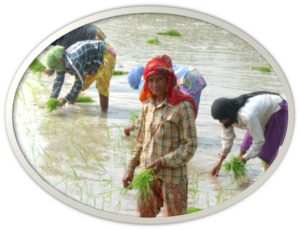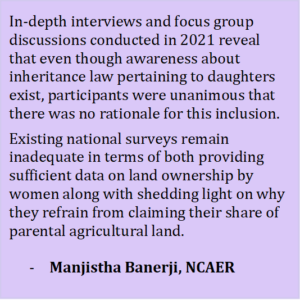
by Dr Manjistha Banerji, NCAER
Currently governed by the Hindu Succession Act of 2005, inheritance laws in the country have undergone unprecedented changes from the Mitakshara and Dayabhaga doctrines that formed the basis of inheritance systems in colonial India. Under these systems, inheritance was primarily patrilineal. Women had weak inheritance rights, with widows enjoying more rights than unmarried daughters, who, in turn, had more rights than married daughters (Agarwal 1998). The Hindu Succession Act was first enacted in 1956 with the objective that sons and daughters and brothers and sisters have equal succession rights. However, several limitations persisted, which defeated the purported objective of gender equality. The Hindu Succession (Amendment) Act passed in 2005 has removed most of these inequalities (EPW Editorial 2005).
Despite a law that mandates equal inheritance rights for men and women, the overall incidence of land ownership by women remains low. As per the 2011- 12 round of the India Human Development Survey, only about 2% of surveyed households reported that female members “inherited” or were “gifted” agricultural land, the corresponding percentage for male members stood at 83%. There is, thus, a gap between the law and practice that needs to be examined.
However, existing data sources do not shed much light on the reasons behind this gap. In fact, there is a paucity of national-level statistics on land ownership and other assets (Kieran et al, 2015). For example, data on asset ownership collected by NSSO All India Debt and Investment Surveys (AIDIS) is limited because asset ownership is measured at the household rather than at the individual level (Swaminathan et al 2012).
 To understand the factors, normative or otherwise, that discourage women from claiming their share of parental land, a team at the NCAER-National Data Innovation Center conducted focus group discussions and in-depth interviews in 2021 in a couple of villages in western Uttar Pradesh as part of the Delhi Metropolitan Area Study (DMAS). These discussions were held among the land-owning Jaat community and also the historically marginalized Jatav community. While not exhaustive, they provide glimpses as to why women’s access to agricultural land remains low in the country.
To understand the factors, normative or otherwise, that discourage women from claiming their share of parental land, a team at the NCAER-National Data Innovation Center conducted focus group discussions and in-depth interviews in 2021 in a couple of villages in western Uttar Pradesh as part of the Delhi Metropolitan Area Study (DMAS). These discussions were held among the land-owning Jaat community and also the historically marginalized Jatav community. While not exhaustive, they provide glimpses as to why women’s access to agricultural land remains low in the country.
It appeared from the discussions that there is awareness about the law entitling daughters to a share of their parents’ property. Yet daughter’s name is typically not included in the property and the participants were unanimous that there was no rationale for the inclusion. On the question as to whether a married daughter ought to make a claim to her parents’ property, the participants were yet again unanimous that they should not. Participants, particularly the elderly in the group, felt that daughters ought to be “happy” with whatever parents give her both before and after marriage. This caveat also holds in instances where not enough dowry was given at the time of the wedding. Younger participants felt that if the daughter is “capable” and “stands on her own two feet”, she will not claim parental property. Otherwise she will. Educated daughters are likely not to claim parental property, but those who are not might make a claim. Indeed, the current practice appears to be that at the time of marriage daughters sign affidavits forgoing their claim to parental property.
Another participant hinted at land fragmentation that would result if she were to claim her share to her parents’ agricultural land (of around 2- 3 bighas). She has two brothers. Sub division of the land into 3 equal parts would make it unviable for cultivation.
What if the parents had no sons and only daughters? Was it okay in this situation for daughters to claim her share of the property? Participants agreed that in this scenario daughters could claim their share, but they thought that in this instance too it was better if the property was given (sold or otherwise) to the other male cousins of the family. We came across only two cases where daughters had claimed their share of the parental property. In one instance, the elderly informant told us that she was pressured to do so by her husband and in-laws who had fallen on hard times and needed the extra cash. In another instance, there were two daughters who inherited their parents’ property (there were no sons). While one of the daughters sold off her share, the other one gave her share of the property to her nephew. Overall, it was difficult for the participants to hypothesize any situation where it was justified for the daughters to claim her parents’ property. The only exception was if the daughter was not yet married at the time of parent’s death.
None of the reasons are new and have been highlighted in the literature before. On the other hand, land ownership by women may be higher in other parts of the country where women marry within their extended kin network or in the same village. However, existing national surveys remain inadequate in terms of both providing sufficient data on land ownership by women along with shedding light on why they refrain (or not) from claiming their share of parental agricultural land. This gap needs to be plugged.
References
Agarwal, B. (1998). “Widows versus Daughters or Widows as Daughters? Property, Land, and Economic Security in Rural India”, Modern Asian Studies, 32 (1), 1- 48.
EPW (2005) ‘Editorial: Groundbreaking Legislation’, Economic and Political Weekly, 40 (42), 4487.
Kieran, C., Sproule, K., Doss, C., Quisumbing, A. R., & Kim, S. M. (2015). Examining gender inequalities in land rights indicators in Asia. IFPRI Discussion Paper (1429). Washington: International Food Policy Research Institute (IFPRI).
Swaminathan, H., Lahoti, R., & Suchitra J. Y. (2012) “Gender Asset and Wealth Gaps: Evidence from Karnataka”, Economic and Political Weekly, Vol. XLVII (35).
Manjistha Banerji, a social demographer, is a Fellow at National Council of Applied Economic Research. Her broad areas of research are family, migration and education, which she studies employing the lenses of gender and social stratification. She is trained in quantitative methods but she also uses qualitative methods to better understand the findings emerging from survey research.